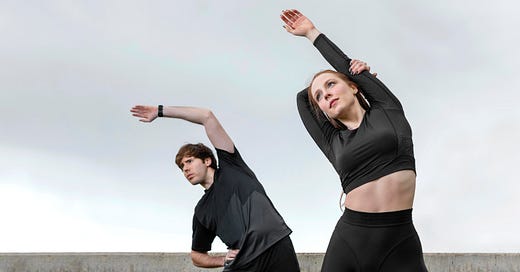Do you know if you're stretching the right way before a workout? Are you tired of feeling unsure about how to properly warm up your muscles? Well, you're not alone. The truth is, not all stretches are created equal and it's important to know which ones to do and when to do them. In this article, we'll reveal the science behind dynamic and static stretching and how they can impact your workout in different ways. By the end of this article, you'll have a clear understanding of which stretches to do before your next workout and how to avoid common injuries. So, let's get started and take your stretching game to the next level!
What is static stretching?
Static stretching is a type of stretching where you hold a particular position, usually for around 30 seconds, without moving. It's commonly done by reaching for your toes or stretching your arms across your chest to feel a stretch in your muscles.
Negative effects of static stretching before a workout:
Decreases muscle power and explosiveness for up to an hour after the stretch if held for more than 30 seconds.
Static stretching weakens muscles, reduces stability, and affects your ability to maintain proper form during exercise, which can lead to compensation from other muscles and imbalances, thereby increasing the risk of injury.
Reduces blood flow to the muscles, which decreases muscle temperature and hinders performance.
The power of dynamic stretching
Dynamic stretching is a type of stretching that's gaining popularity among fitness enthusiasts, athletes, and sports coaches. Unlike static stretching where you hold each position for an extended period of time, dynamic stretching involves moving your body through a range of motion, briefly tapping or holding each position for approximately one second. This type of stretching aims to prepare your muscles for the activity ahead and promote flexibility and mobility without overstretching the muscles. So, what are the benefits and drawbacks of dynamic stretching? Let's take a closer look at the pros and cons.
Benefits of dynamic stretching:
Boosts performance:
Research has shown that dynamic stretching can improve performance during exercise. By priming your muscles and preparing them for the activity ahead, dynamic stretching can help you perform at your best.
Improves range of motion:
By moving your body through a range of motion, dynamic stretching can help improve your overall flexibility and range of motion. This can lead to better performance during exercise and reduce the risk of injury.
Enhances neuromuscular coordination:
Dynamic stretching can help improve the connection between your muscles and nervous system, which can lead to better coordination and control during exercise.
Increases muscle temperature:
Dynamic stretching helps increase blood flow to your muscles, which in turn increases muscle temperature. This can improve muscle elasticity and reduce the risk of injury during exercise.
Did you know?
Incorporating dynamic stretching before weightlifting can lead to a 5.4% increase in one-repetition maximum for the bench press. This improvement in strength can make a significant difference in weightlifting performance and overall athletic ability. In addition, dynamic warm-ups and stretching have been shown to lead to a 3.7% increase in vertical jump height, a 2.6% improvement in sprint time, and a 4.4% improvement in agility performance. These exercises can also reduce the risk of muscle strains and overall injury risk by up to 48% and 33%, respectively, as reported by a review of studies published in the British Journal of Sports Medicine.
Beginner's pre-workout warm-up routine
Dynamic Warm-Up:
Jog in place: 1-2 minutes
Jumping Jacks: 10-20 repetitions
High Knees: 10-20 repetitions
Butt Kicks: 10-20 repetitions
Arm Circles: 10-20 repetitions (forward and backward)
Leg Swings: 10-20 repetitions (forward and backward)
Hip Circles: 10-20 repetitions (each direction)
Walking Lunges: 10-20 repetitions (each leg)
Dynamic Stretching:
Walking Lunges with a Twist: 10-20 repetitions (each leg)
High Kicks: 10-20 repetitions (each leg)
Standing Quad Stretch: 10-20 repetitions (each leg)
Inchworms: 5-10 repetitions
Shoulder Stretch: 10-20 repetitions (each arm)
Note:
During the dynamic stretching routine, it is important to remember that you will not be holding each position for an extended period of time. Instead, aim to briefly tap or hold the position for approximately one second before moving on to the next repetition. This will help to promote flexibility and mobility without overstretching the muscles.
Final thoughts
Although dynamic warm-ups are generally recommended for most physical activities, not all activities prohibit static stretching. Certain activities, such as dance, gymnastics, yoga, and martial arts, may require static stretching as part of their training. These activities often require a high degree of flexibility and range of motion, and static stretching can help to improve and maintain this flexibility over time.
In dance and gymnastics, for example, static stretching can help to increase the range of motion in joints and muscles, allowing for greater flexibility and control in movements. Similarly, in yoga and martial arts, holding poses for longer durations can help to increase flexibility and strengthen the body.
However, it's important to note that static stretching should still be done with caution and under the guidance of a trained professional. Overstretching can lead to injury, and it's important to find the right balance between static and dynamic stretching based on your individual needs and goals.
Message to Readers
“Embrace the pain of discipline, for it is the key to unlocking your potential. Every rep, every stretch, every warm-up is a step towards greatness. So don't let the pain of regret hold you back - show up, put in the work, and unleash your inner strength!”
—The Boring Fitness








Great points I didn't know about dynamic stretching. I will make some adjustments to my warm up routine.
I found the article to be really helpful. Your explanation of the benefits of dynamic stretching versus static stretching was clear and informative. Thank you for sharing your knowledge!